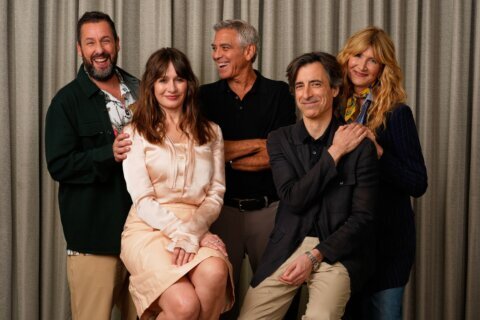WASHINGTON — There’s no denying that Darren Aronofsky’s “Requiem for a Dream” (2000) and Vince Gilligan’s “Breaking Bad” (2008) are masterworks, functioning as better anti-drug campaigns than any D.A.R.E. political initiative.
And yet, these gems wouldn’t exist without the original genius of “Trainspotting” (1996), an acid trip of a flick that launched Scottish star Ewan McGregor and British director Danny Boyle, while burning images into our brains of drug addicts plunging through the floor and hallucinating babies on ceilings.
This weekend, the dynamic duo relapses for “T2: Trainspotting,” a sequel no one knew they wanted or needed, but one that sizzles with alive, kinetic energy thanks to Boyle’s visceral filmmaking style.
Based on Irvine Welsh’s 2002 novel “Porno,” the sequel to his 1993 novel “Trainspotting,” we pick up 20 years after recovering addict Mark Renton (Ewan McGregor) skipped town to Amsterdam with 16,000 pounds of drug money, leaving behind disproportionate amounts to his partners in crime.
Older but only slightly wiser, Mark returns to Edinburgh to reunite with his old pals, Daniel “Spud” Murphy (Ewen Bremner), who’s relapsed with heroine, and Simon “Sick Boy” Williamson (Jonny Lee Miller), who’s now a cocaine junkie running both a pub and a blackmail business. All the while, the violent psychopath Francis “Franco” Begbie (Robert Carlyle) furiously tries to escape from prison.
There’s no denying the baked-in rush of the band getting back together, with a jolt of nostalgia each time an original cast member is reintroduced. Likewise, McGregor, Bremner, Miller, Carlyle, and Kelly Macdonald all seem to be having a ball back together with their old pals like a high school reunion.
Of course, a lot’s changed since 1996. Amy Winehouse, Heath Ledger and Philip Seymour Hoffman have all tragically overdosed. McGregor has become a musical superstar with “Moulin Rouge” (2001). And Boyle has become an Oscar champ with the Best Picture winner “Slumdog Millionaire” (2008).
At times, “T2” feels like the sequel no one even asked for. Some of the original edge is worn off with once gritty actors now known for commercial projects, from Carlyle in ABC’s “Once Upon a Time” to McGregor in Disney’s “Beauty and the Beast.” (Why is Rumpelstiltskin trying to kill Lumiere?!?)
Not to worry: The vibe is still very much “Trainspotting,” with tons of self-referential gags and plenty of drugs, vomit, profanity, nudity and sex toys. The script is, once again, adapted by John Hodge, who earned an Oscar nod the last time around. Here, Hodge pens wisdom, “Be addicted to something else,” while echoing a wistful thematic refrain: “First there was opportunity, then there was betrayal.”
Easily the best part of the script is McGregor’s “choose life” monologue, once again riffing on the anti-drug campaigns from the ’80s, only now with astute cultural criticisms for the post-9/11 digital age. These societal diagnoses are especially ironic considering Boyle just directed “Steve Jobs” (2015).
But the more things change, the more they stay the same, even with new collaborators on the crew. Replacing 1996 editor Masahiro Hirakubo is Jon Harris, who teamed with Boyle on “127 Hours” (2010), and filling in for 1996 cinematographer Brian Trufano is Anthony Dod Mantle, who worked with Boyle on “28 Days Later…” (2002), “Slumdog Millionaire” (2008) and “127 Hours” (2010).
Perhaps most memorable from the 1996 original was its soundtrack, namely Underworld’s “Born Slippy,” which became the de-facto “Trainspotting” theme. The electronic track makes a glorious return here, along with several nice additions, such as a rave scene set to Queen’s “Radio Ga Ga.”
It was this marriage of daring visuals and intoxicating songs that made “Trainspotting” a turn-of-the-millennium “Easy Rider” (1969) for a new generation. Like Dennis Hopper’s trippy acid intercuts in that Baby Boomer classic, Boyle once again returns to his cinethestic roots with a gritty, flashy style.
The filmmaker throws out the kitchen sink (or porcelain toilet) with a flurry of directing techniques, featuring freeze frames, dutch angles, smash cuts, off-kilter POVs, lens flares, fast motion, slow motion, even animated graphics over people’s faces in CCTV footage. Most creative is text that appears superimposed on screen, be it dialogue between two characters, text messages under the table, elevator floor numbers on the side of a building, or pin numbers appearing over ATM machines.
Particularly well directed is an early sequence as Mark comes upon the locked door of a suicidal pal. In a dynamic display of triple parallel action, we see (A) Mark in the hallway, (B) the friend dying on the floor inside, and (C) a surreal representation of the friend’s soul slowly falling from a building.
Also impressive is a billiard brawl with floor-level close-ups of a stool flying at the camera, a bar-level close-up of a handbell being snatched as a weapon and hilarious cutaways to an old man casually sipping his beer amid the chaos. It’s the best pool-hall fight sequence since Robert DeNiro swung a cue stick in “Mean Streets” (1973) — Scorsese fans will also love the homage to “Raging Bull” (1980).
These flashy techniques aren’t done solely for superficial effect. Instead, there’s an admirable level of thematic weight to the imagery. You’ll notice consistent reflections in window frames and bathroom tiles, suggesting the wiser characters are reflecting back on their poor life choices. You’ll also notice images of rotation, from restaurant conveyor belts to gym treadmills, conveying the notion that these addicts are trapped on a treadmill, always trying to outrun themselves, ready to relapse and collapse.
It all builds to a killer final shot that’s both nostalgic and inventive, eliciting a brilliant train tunnel perspective. It’s this culminating shot that sums up the entire movie — visually impressive to first-time viewers, but thematically rewarding for fans of the 1996 original. In the end, that’s who this movie is meant for. If you’re not already a fan, you can probably skip it, like a traveler waiting to catch the next train. But if you’re a diehard, you’ll gladly pull back into this trippy station one more time.








